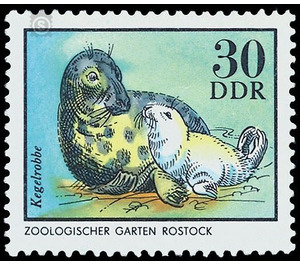zoo animals - Germany / German Democratic Republic 1975 - 30 Pfennig
Theme: Animals
| Country | Germany / German Democratic Republic |
| Issue Date | 1975 |
| Face Value | 30.00 |
| Color | blue |
| Perforation | K 13:13 1/2 |
| Printing Type | offset |
| Stamp Type | Postage stamp |
| Item Type | Stamp |
| Chronological Issue Number | 1777 |
| Chronological Chapter | GER-DDR |
| SID | 254902 |
| In 25 Wishlists | |
Interesting animals from the zoos and zoological gardens of the GDR The Ministry of Posts and Telecommunications of the German Democratic Republic issues eight multi-colored special postage stamps with pictures of interesting animals from the zoos and zoological gardens of the GDR. Interesting animals from the zoos and zoological gardens of the GDR 30-pfennig value: gray seal, Zoologischer Garten Rostock The most common seal in the Baltic Sea is the gray seal (Halichoerus grypus). The German name refers to the outstretched conical snout. In the countryside, this three-meter-long seal can elevate the upper body very high, using the front fins as a balancing pole. The males collect a harem from several females vigorously defended against rivals. The boys are born on shore areas that are not normally reached by high tide. The gray seals are born with long, soft, really yellow wool hair, the embryo dress. Only after the boy has lost this, and the change to normal dress is completed, the four to five weeks old animal goes into the water. The mother follows her cub. Although the gray seal differs greatly from the actual seals of the genus Phoca, once a bastard between gray seal and ringed seal (Phoca hispida) was born in the Stockholm Zoo "Skansen". The gray seal is kept in several zoos but rarely reproduced. Every year, one or two gray seals come to the Warsaw Zoo for rearing. Since 1956, the gray seal as a marine mammal enjoys a special popularity with the zoo visitors. This species of seal, which has become very rare in the Baltic Sea, is under protection in the GDR. In the Zoological Garden Rostock several gray seals were born, but so far not successfully raised.


